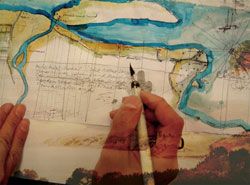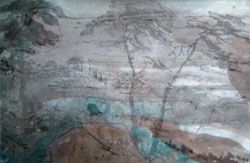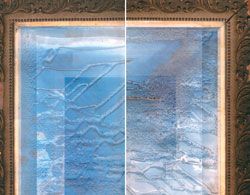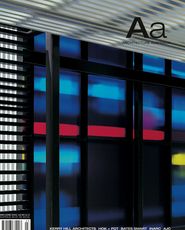
Drawing by Steve Loo, Sarah Treadwell and John Macarthur from Marco Frascari’s Verso Recto workshop.

Outcomes of Frascari’s Verso Recto workshop. Drawing by Steve Loo, Sarah Treadwell and John Macarthur.

‘Drawings’ by Sean Pickersgill, Bill Taylor and Justine Clark.
The Energy and allure of civic festivals lies, in part, in their potential to generate events at the margins of the official programme. The juxtaposition and convergence of diverse cultural forums provides for engaging overlaps and serendipitous dialogue and exchange. The 2004 Adelaide Festival of the Arts framed two independent yet complementary architectural events. The Architecture Symposium was embedded within the festival’s Artist’s Week visual arts programme and attracted a huge audience, while the more intimate academic symposium on architectural drawing, The Grimoire of Architecture, was organized and hosted by the University of South Australia.
Curated by Rachel Hurst, both events were broadly shaped by her interest in the rituals of everyday life and their relevance to architectural design and production. More specifically, the Architecture Symposium promoted an analogous reading of architecture and gastronomy.
Academics, practising architects and cultural commentators were invited to reflect upon the polemics of place, region and sustainability, through a parallel discussion on architecture and cuisine. The symposium on architectural drawing assumed a more specialized role. Conceived as a scholarly forum, it called for a focused discussion on architectural drawing with particular reference to the work of architectural theoretician, Marco Frascari. Indeed, despite their thematic autonomy, the two events were linked through the presence of Frascari, the keynote speaker at both forums.
Frascari approaches architectural interpretation from an analogical standpoint. His discourse belongs to a tradition of architectural theory that retrieves analogical devices from the past in order to address apparent shortcomings in the present. Conceptual models derived from gastronomy, phenomenology and experimental linguistics, he argues, have the capacity to critique contemporary attitudes to design and to suggest new directions for the making of meaningful buildings. A charismatic raconteur, he develops his arguments through historical allegories, fables and the telling of enjoyable tales. Through this captivating approach, he opens intriguing questions without assuming the possibilities of final answers.
The Architecture Symposium opened with Frascari’s address, mischievously called “Cheese, Cheese, Cheese”. In lamenting the overt visuality of contemporary architectural productions, he called for a tactile approach to the making and interpretation of architecture.
His argument was pursued with reference to the sensorial and alchemic dimension of gourmet cooking. An intelligent design procedure, he claimed, must be based on the imaginative anticipation of the sensorial impact of the building on its inhabitants.
For Sarah Wigglesworth, the symposium’s second keynote speaker, the parallel discussion of food and architecture allowed a critique of these two highly codified modes of cultural production. Referring to her architectural project The Straw Bale House and Quilted Office, she positioned her practice as a site for experimentation – one that resists the authority of fashion and industrialized processes. Her approach, she argued, is based on an “inventive” reconfiguration of programme, tectonic systems, and material “correctness”. While Wigglesworth’s promotion of a tactile and a “craft”-based architecture echoed Frascari’s sentiments, her theoretical and aesthetic frames of reference were quite distinct, and drew from debates on sustainability.
Local attitudes to ecology and regional identity were voiced in the afternoon session, composed of short presentations and discussion forums. Highlights included Timothy Hill’s tangential discussion of sustainability through the notion of architecture as “considered work”, and Kerstin Thompson’s elegant notes on travel and cuisine, which provided a nuanced reading of local identity. Through displacement and borrowings, Thompson suggested, global styles and modes of practice inevitably shift and gain cultural inflections and local accents.
Steve Loo’s and Peter Tonkin’s refreshing insights on place-making offered a fluid account of regional character. Loo called for an interpretive approach to conservation where an emotional and sensual engagement between the participant and the architectural work provides for a complex understanding of regional identity. The inscription of identity in place, Tonkin suggested, occurs through an intricate exchange between the building materials, the site, local histories and stories, and artistic practices and crafts.
The symposium’s final speaker, culinary expert Stefano de Pieri, delivered a humorous and passionate attack on the homogenized character and “excessive” nature of current trends in rural development. The art of living and eating well, cooking and building well, he argued, must be founded upon local culture, its character and particularities.
While “gastronomy” represented a marginal, albeit tantalizing, vehicle for architectural discussions, the theme of “drawing” provided an indispensable device for architectural discourse and practice. The Grimoire of Architecture: A Symposium on Architectural Drawing and the Work of Marco Frascari provided an opportunity to exchange diverse views about the role of drawing in architecture. In leading the dialogue, Frascari staged a critique of the reductive nature of digital techniques and modes of representation. Dismissing the computer screen as two dimensional and single-sided, he privileged the “thickness” and two-faceted nature of the drawing paper. The bodily and tactile interface between the paper and the drafting media, he suggested, allows for “synesthetic” image making – the marking and mapping of cross-sensorial and emotive spatial perceptions.
Invited academics framed their response within established and stimulating fields of research. While some made a direct reference to Frascari’s work, others pursued alternative lines of enquiry. Themes included the human figure and the architectural drawing, the picturesque, drawing and the index, colonial drawings, the ethics of drawing, marks as systems of practice, and the construction of lightness.
Programmed across two days, the symposium culminated with a series of workshops.
This welcome deviation from conventional academic procedures allowed for a hands-on approach to architectural theory and deployed the drawing surface as a productive space for scholarly work and reflection. The symposium closed with an exhibition of the work, including seductive watercolour and ink renderings by Steve Loo, John Macarthur and Sarah Treadwell, and striking digital scans by Sean Pickersgill, Justine Clark and Bill Taylor.
In their autonomy and juxtaposition, both symposiums provided valuable opportunities for talking through issues and ideas pertinent to the discipline and practice of architecture. Food, cuisine and gourmet productions presented compelling analogies. For the festival audience, they proved popular and accessible frames of reference and for the invited practitioners, an unexpected theoretical lens – leading to fresh and insightful accounts of their practice. Hosted by the University of South Australia, the drawing symposium was attended by students and made a valuable contribution to their curriculum. In its scale, focus and unconventional format, it provided a valuable alternative to the larger and thematically inclusive events that characterize architectural conferences in Australia. Despite thematic specifity and careful calibration of the programmes, however, there was a disappointing level of public discussion amongst the delegates. The concluding panels were subdued and did not lead to intricate questions or the teasing out of theoretical alignments or misgivings. In particular, the diverse polemics that underpinned the Architecture Symposium brought about complex tensions that are well worth exploring. For instance, the seemingly irreconcilable gap between the poetics of the “good life” – and the privileges that it affords – and the ethics of a “sustainable life” deserved considered attention. Indeed, the alignment of the “everyday” with the gourmet, the crafted and the rarefied modes of production left little room for the consideration of the “mundane” and the “ordinary” – in their aesthetics or implied processes. Marco Frascari traversed the two symposiums with ease. Ultimately, his appeal stems from the ability to entice his audience to think with and alongside him, whether in similar or divergent ways, about leading the good life, whilst being good!















